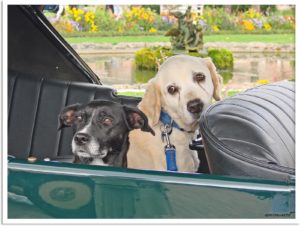 If planned right, your trip can become even more fun if you bring your furry best friend with you. But traveling with your dog requires more effort than just booking a pet friendly hotel. On the other hand, it can be a nightmare if your dog is not well trained. So ideally, first make sure that your dog is well-behaved at home before planning such an adventure. It will not only make your life easier but it will also contribute to your dog’s wellbeing in the long-term. A trained dog is a happy dog.
If planned right, your trip can become even more fun if you bring your furry best friend with you. But traveling with your dog requires more effort than just booking a pet friendly hotel. On the other hand, it can be a nightmare if your dog is not well trained. So ideally, first make sure that your dog is well-behaved at home before planning such an adventure. It will not only make your life easier but it will also contribute to your dog’s wellbeing in the long-term. A trained dog is a happy dog.
Country Regulations
 Each country has specific regulations your dog needs to meet before entering the country. Make sure that you review the customs laws of the country you’re traveling to. Unfortunately, there isn’t a one-stop resource for this. Each country is different. So make sure to leave plenty of time before your trip to deal with this paperwork.
Each country has specific regulations your dog needs to meet before entering the country. Make sure that you review the customs laws of the country you’re traveling to. Unfortunately, there isn’t a one-stop resource for this. Each country is different. So make sure to leave plenty of time before your trip to deal with this paperwork.
Surely, you don’t want to take your dog somewhere where it will be held in quarantine for several days or weeks! So you might want to reconsider taking your dog to Australia or China if you don’t have to. Otherwise for most countries, your dog will need a passport and all the health certificates from your vet that show a proof that your dog is healthy and that it has been vaccinated.
Now, to travel from a rabies free country to most European countries is pretty straightforward. Your dog just needs to be micro-chipped and have a proof of rabies vaccinations. But, if you are coming from outside the EU, your dog will need a rabies antibodies blood test that is certified by a specific EU approved lab. Although some sites claim that these should not be older than a year, it is much more simple. If you vaccinate your dog each year on the same day or earlier, the test has an indefinite duration date. These tests are actually quite costly so other than your pet not having to go through the trauma again, your wallet will also thank you. So make sure not to skip that date in the year as you cannot afford being a single day late!
Also, United Kingdom, the Republic of Ireland, Malta, Finland and Norway require an additional tapeworm treatment but more on that later.
Traveling by car

Automobiles are perhaps the easiest way to travel with your dog. That is unless your dog gets sick in the car. So it is very important to teach it what this feels like from an early age. To begin with, you should start with short rides that end up at fun places! Take your dog to the pet store or to the park. What many dog owners do is take the car only to go the vet and help their dogs to label cars as ‘roadway to hell’ so make sure you do not make this mistake! They will still know if you are in your vet’s neighbourhood but at least they won’t connect this petrifying experience to the car ride itself!

Make sure to plan plenty of breaks. You also need to get a transporter or dog seat belt or car harness– it all depends on the size and behaviour of your dog. You also have barriers that keep your dog from distracting you in the back seat, but they are not as effective as a harness or a crate.
If you opt for a dog car seat, just make sure that is not a merely modified dog bed that is very unsafe! It needs to be securely attached to the seat AND have a clip that attaches to your dog’s harness. By no means should you attach it to your dog’s collar as it could strangle your dog in case of a crash.
Traveling by plane
First and foremost, it is up to you to reduce any sort of anxiety the trip can cause to your dog. Luckily, there are many natural travel anxiety supplements that you can try as there are many conflicting opinions on sedatives.
Unfortunately, if you own a dog that weighs more than 8kgs within its bag, your friend cannot travel in the cabin with you. On the one hand, millions of pets are shipped every year yet there are many horror stories with dogs that were traveling in the cargo area. So if at all possible, do try to avoid that your pet travels with your luggage.
Cabin Travel
So, small dog owners are in luck but only if their dog’s carrier can fit within the given dimensions. Each airline has its own rules so you need to do a detailed research. Ryanair and Wizzair do not accept pets. British Airways only accept emotional support dogs but only up to 6kgs. Lufthansa and Swiss are luckily here to save the day! As long as your dog along with its transportation box does not exceed 8kgs and the dimensions of the container are within the 55x40x23cm (22x16x9inches) range. If you’re good with those, all you need is to fill a form.
There are other pet-friendly airlines but each is different as for example Air Serbia has different dimensions of only 40 cm (length) x 30 cm (width) x 24 cm (height). American Airlines for example are even more flexible and allow up to 9 kgs yet they have restrictions on breeds. Fees also vary, but are around 20-60 GBP per flight when it comes to Europe and more for other continents. Unfortunately, when it comes to some countries, your dog cannot be in the cabin with you, even on these airlines. These countries are:
- Australia
- Hong Kong
- Ireland
- Kenya
- South Africa
- United Arab Emirates
- United Kingdom (there are exceptions to certain airports, but only with Lufthansa)
But most importantly, your pet needs to be able to stand up and be comfortable within its carrier. Along with adequate ventilation, the bag should also have a waterproof bottom.
Your pet’s luggage
 Make sure you bring a first-aid kit. Also, just like people require vaccines for some regions, your dog might need some additional protection. An example is going to the seaside in which case you need to protect your dog from heart-worms that are carried by mosquitos. There are many heart-worm protection tablets such as Interceptor. You also have Spectra which is new on the market but also covers protection against ticks and fleas.
Make sure you bring a first-aid kit. Also, just like people require vaccines for some regions, your dog might need some additional protection. An example is going to the seaside in which case you need to protect your dog from heart-worms that are carried by mosquitos. There are many heart-worm protection tablets such as Interceptor. You also have Spectra which is new on the market but also covers protection against ticks and fleas.
You also have more natural remedies like WRM Clear which can aid in and even support the removal of tapeworm, whipworm, roundworm, and hookworm. Such natural remedies do not kill the worms but help your pet’s immune system to clean them naturally. Probably the best would be to give your pet the chemical pill and support it with the natural alternative to help it detox from it. It is good to have such aid with you in case your dog is sensitive to the chemical worm remedy. Intolerance to the remedy will be reflected by vomiting, diarrhea or a skin rash.
It is always a good idea for both of you to bring a spray with the potent Geranium oil to spray around when going for walks as insects and even ticks are repelled by it.
Needless to say, bring your dog’s favourite blanket and a couple of toys along with its food with you!
Before you go…
 Make sure that your dog is in an optimal health to travel in the first place. Take a long walk before the trip. It will not only help your dog finish its business but it will also help in relaxing it for the trip. Just like with kids, measure their water and food intake if it’s a very long trip! And plan wisely – each break, meal and water intake to make sure your dog is well-taken care of!
Make sure that your dog is in an optimal health to travel in the first place. Take a long walk before the trip. It will not only help your dog finish its business but it will also help in relaxing it for the trip. Just like with kids, measure their water and food intake if it’s a very long trip! And plan wisely – each break, meal and water intake to make sure your dog is well-taken care of!
Have a safe and fun journey :)









